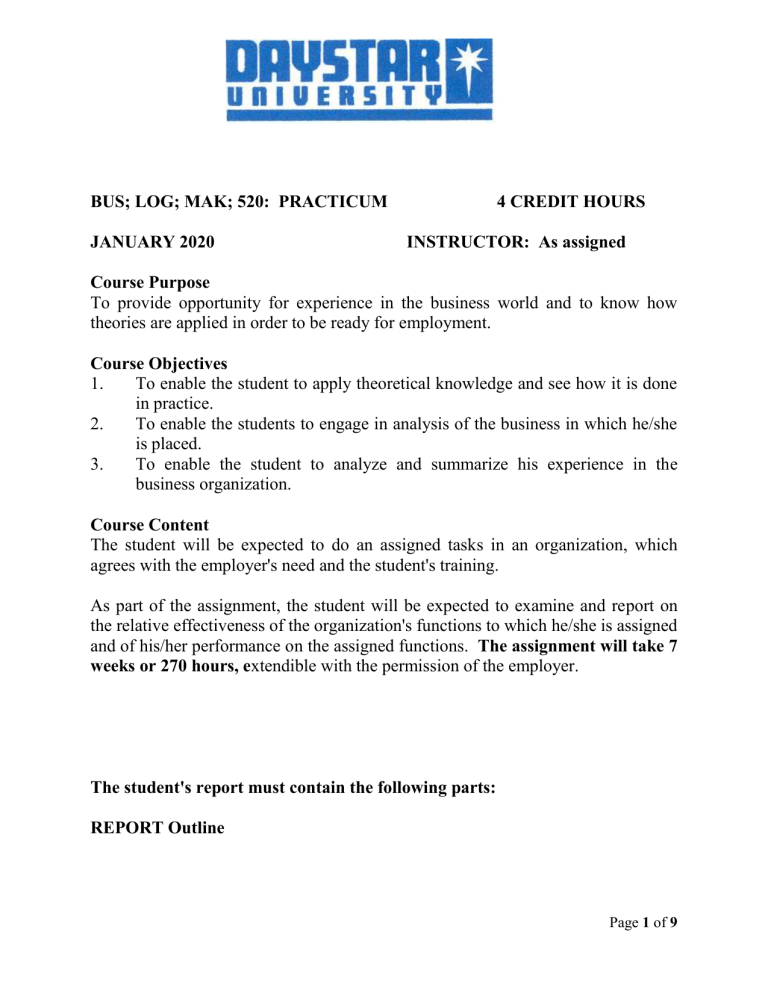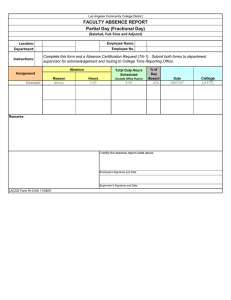
BUS; LOG; MAK; 520: PRACTICUM JANUARY 2020 4 CREDIT HOURS INSTRUCTOR: As assigned Course Purpose To provide opportunity for experience in the business world and to know how theories are applied in order to be ready for employment. Course Objectives 1. To enable the student to apply theoretical knowledge and see how it is done in practice. 2. To enable the students to engage in analysis of the business in which he/she is placed. 3. To enable the student to analyze and summarize his experience in the business organization. Course Content The student will be expected to do an assigned tasks in an organization, which agrees with the employer's need and the student's training. As part of the assignment, the student will be expected to examine and report on the relative effectiveness of the organization's functions to which he/she is assigned and of his/her performance on the assigned functions. The assignment will take 7 weeks or 270 hours, extendible with the permission of the employer. The student's report must contain the following parts: REPORT Outline Page 1 of 9 COVER PAGE – sample DAYSTAR UNIVERSITY PRACTICUM REPORT CODE: (e.g. MAK 520; LOG; BUS 520) By NAME OF STUDENT ADMISSION NUMBER Semester undertaken and year (e.g. August 2019) School Of Business and Economics Page 2 of 9 Title page: sample The Title; e.g. 'A Report on …KARIANDUSE MINING COMPANY....' 'An Investigation into...' 'An Analysis of ...' 'A Comparison of ... and ...' Your Name Your student number. Submitted in partial fulfilment of the requirement of the ............................course. , The date Submitted to the School of Business and Economics, Daystar University, in partial fulfilment of the requirement of the Bachelor of Commerce (B.Com) degree. Page 3 of 9 Declaration and Signature page – i. Where a student declares the work is an original work, and has not been submitted anywhere else for academic purposes; ii. Student name and admission number, signature and date. iii. Supervisors name, signature and date. Sample: I, NAME OF STUDENT AND ADMISSION NUMBER; declare that this is my original work, and has not been submitted anywhere else for academic purposes. SIGNATURE: DATE: University Supervisor’s Name: Signature: DATE: Page 4 of 9 I Preface - A preface or foreword deals with the genesis, purpose, limitations, and scope of the book/report and may include acknowledgments of indebtedness. Its purpose is to provide a framework for what's to follow. Sample II Acknowledgement- the action of expressing or displaying gratitude or appreciation for something. Acknowledgement section is used to thank all those people who have helped you directly or indirectly in preparing your project. Here is a sample acknowledgement which you use in your projects. ACKNOWLEDGEMENT Every project big or small is successful largely due to the effort of a number of wonderful people who have always given their valuable advice or lent a helping hand. I sincerely appreciate the inspiration; support and guidance of all those people who have been instrumental in making this project a success. I, am extremely grateful to “COMPANY” for the confidence bestowed in me and entrusting my project entitled “” with special reference to COMPANY Name. At this juncture I feel deeply honoured in expressing my sincere thanks to Name of supervisor at company for making the resources available at right time and providing valuable insights leading to the successful completion of my project. Page 5 of 9 I express my gratitude to College Director Name for arranging the practicum/internship training in good schedule. I also extend my gratitude to my Project Guide Faculty Name, who assisted me in compiling the project. I would also like to thank all the faculty members of college name for their critical advice and guidance without which this project would not have been possible. Last but not the least I place a deep sense of gratitude to my family members and my friends who have been constant source of inspiration during the preparation of this project work. NB: Attach an official letter from the organization in the space after acknowledgement. III Table of Contents IV List of abbreviations and acronyms NB: all front matters-title page, preface, abstract, acknowledgement, table of contents, list of abbreviations, etc. The prefaces and foreword are not integral to the book and are numbered separately, along with other front matter, with lowercase roman numerals: i, ii, iii, iv, etc., starting with the book's opening page. V Introduction - Introduction, refer to material given at the front of a book, report, etc., to explain or introduce it to the reader. An introduction deals with the subject of the book, supplementing and introducing the text and indicating a point of view to be adopted by the reader. 1. Introduction Background This report has been written because.... It was requested by... It was requested on (date). Page 6 of 9 Objectives The objectives of this report are to .... Scope This report examines .... . It does not examine ..... because ...... (In this case, it should give a brief information on the reason for practicum or industrial attachment as a course in Daystar University; introduction of the institution the attachment was undertaken in; and the outcomes or benefits to the student). The introduction usually forms a part of the text [and the text numbering system]. Part I: Diary a) Daily activities (attach the raw diary as part of the report, without pagination). b) Sections/departments assigned to: * Any co-operation from section colleagues or frustrations in carrying out your assigned duties. * Any interruptions, i.e. unofficial activities, telephone calls, sickness, etc. NB: provide a weekly summary of the work done, as clearly as possible. Part II Work Description a) Sections/departments worked; aggregate the various jobs/tasks done in each section or department and then give clear description of procedures or processes you undertook to do the tasks assigned. b) Their relationship/co-ordination with other departments. c) Who benefits from your work or who suffers in case anything goes wrong from your part (working of systems and the sub-systems in the organization) d) How does the tasks you did match with the courses you did in your degree programme. Page 7 of 9 Part III a) b) c) d) Part IV Organizational Description Give the organization structure in two forms: i) Overall structure ii) Departmental structure, especially those worked in. What are the organization's goals and objectives?-these need to be specified How is the organization attempting to meet the goals and objectives? Make mention of the organization climate and culture (e.g. people or task oriented, rituals and stories, job satisfaction, job involvement, job commitment, etc.). The Industry- provide information on: a) Which industry the firm is in, b) the kind of organization set up it has, i.e. multinational, licensed, franchise, joint venture, etc.? (Explain or describe). c) whether it is facing any competition , and what kind they are, and if it is receiving any support from competitors, e) the organization’s SWOT analysis f) its future (explain) by looking at its trends and in relation to the SWOT ANALYSIS. g) Conclusion e) Give suggestions and Recommendations. NB: exemption for diploma students part iv (f) only References – sources of information referred to in writing the report. Appendices – extra supporting material Page 8 of 9 NOTE: 1. The project/report must be more than 55 pages, typed in double space. 2. The project/report must be hard cover bound (one for the department), and printed on the outside (see instructor/supervisor if in doubt). 3. The completed raw diary to be attached in part A, the job diary 4. A copy for the student (optional). Teaching Methodologies Assigned practical task in business environment. Visit by supervising faculty member. Reading and self-report(s). Instructional Material/Equipment Such as is provided at the workplace relevant to the assigned task. Student Assessment Student report and job diary. Employer assessment - punctuality, competence, reliability. Faculty observation (Faculty responsible to assigning marks). Textbooks As directed by the lecturer/supervisor in charge. Further Readings Same as above (textbooks). Page 9 of 9

